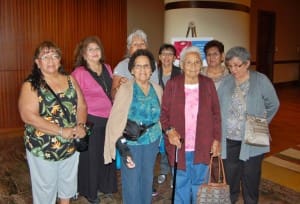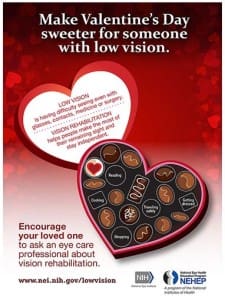This February we send a special Valentine’s Day greeting to our Elders! The following are health and wellness tips and resources especially with you in mind.
Randella Bluehouse, NICOA’s Executive Director shares her favorite chili recipe in honor of National Chili Day February 25! You can share your favorite recipe too by emailing it to [email protected]!
Randella’s Favorite Chili Recipe
3 tablespoons olive oil
2 medium yellow onions, medium dice
1 medium red bell pepper, medium dice
6 medium garlic cloves, minced
1/4 cup chili powder
1 tablespoon ground cumin
2 pounds lean ground beef or ground turkey
1 1/2 teaspoons kosher salt, plus more as needed
1 (28-ounce) can diced tomatoes
1 (14-ounce) can tomato sauce
2 (15-ounce) cans kidney beans, drained and rinsed
1/4 cup coarsely chopped pickled jalapeños or green chili, drained (optional)
- Heat the oil in a large frying pan over medium heat until shimmering. Add the onions and bell pepper, season with salt, and cook, stirring occasionally, until softened.
- Add the garlic, chili powder, and cumin, stir to coat the vegetables, and cook until fragrant, about 1 minute. Add the ground beef or turkey, salt and cook.
- Transfer the mixture to the slow cooker, add the diced tomatoes and their juices, tomato sauce, and beans, and stir to combine. Cover and cook until the chili thickens about 8 hours on low or 6 hours on high.
- Stir in the jalapeños or green chili. Taste and season with salt as needed, and serve with the cheese, scallions, and sour cream if desired.
Heart Health Tips
Honoring Traditions with the Heart in Mind – Heart Healthy American Indian Recipes
http://www.nhlbi.nih.gov/health/educational/healthdisp/pdf/recipes/Recipes-Native-American.pdf
Preventing Heart Disease & Stroke among American Indians and Alaska Natives
Prevent and Control High Blood Cholesterol High blood cholesterol is a major risk factor for heart disease. Preventing and treating high blood cholesterol includes eating a diet low in saturated fat and cholesterol and high in fiber, keeping a healthy weight, and getting regular exercise. All adults should have their cholesterol levels checked once every five years. If yours is high, your doctor may prescribe medicines to help lower it.
Prevent and Control High Blood Pressure Lifestyle actions such as healthy diet, regular physical activity, not smoking, and healthy weight will help you to keep normal blood pressure levels. Blood pressure is easily checked, and all adults should have it checked on a regular basis. If your blood pressure is high, you can work with your doctor to treat it and bring it down to the normal range. A high blood pressure can usually be controlled with lifestyle changes and with medicines when needed.
Prevent and Control Diabetes Diabetes has been shown to be a very important risk factor for heart disease among American Indians and Alaska Natives.* People with diabetes have an increased risk for heart disease but can reduce their risk. Also, people can take steps to reduce their risk for diabetes in the first place, through weight loss and regular physical activity. For more information about diabetes.
No Tobacco Chewing, dipping, and cigarette smoking are non-traditional uses of tobacco among American Indians and Alaska Natives. Smoking increases the risk of high blood pressure, heart disease, and stroke. Never smoking is one of the best things a person can do to lower their risk. And, quitting smoking will also help lower a person’s risk of heart disease. A person’s risk of heart attack decreases soon after quitting. If you smoke, your doctor can suggest programs to help you quit smoking. For more information about tobacco use and quitting.
Moderate Alcohol Use Excessive alcohol use increases the risk of high blood pressure, heart attack, and stroke. People who drink should do so only in moderation and always responsibly.
Maintain a Healthy Weight Healthy weight status in adults is usually assessed by using weight and height to compute a number called the “body mass index” (BMI). BMI usually indicates the amount of body fat. An adult who has a BMI of 30 or higher is considered obese. Overweight is a BMI between 25 and 29.9. Normal weight is a BMI of 18 to 24.9. Proper diet and regular physical activity can help to maintain a healthy weight.
Regular Physical Activity Adults should engage in moderate level physical activities for at least 30 minutes on most days of the week.
Diet and Nutrition Along with healthy weight and regular physical activity, an overall healthy diet can help to lower blood pressure and cholesterol levels and prevent obesity, diabetes, heart disease, and stroke. This includes eating lots of fresh fruits and vegetables, lowering or cutting out added salt or sodium, and eating less saturated fat and cholesterol to lower these risks.
Treat Atrial Fibrillation Atrial fibrillation is an irregular beating of the heart. It can cause clots that can lead to stroke. A doctor can prescribe medications to help reduce the chance of clots.
Genetic Risk Factors Stroke can run in families. Genes play a role in stroke risk factors such as high blood pressure, heart disease, diabetes, and vascular conditions. It is also possible that an increased risk for stroke within a family is due to factors such as a common sedentary lifestyle or poor eating habits, rather than hereditary factors.
Support for Caregivers
Family Caregiver Alliance
For those caring for family members with chronic health conditions of all kinds, this Web site offers factsheets, monographs, policy and statistical documents, and consumer and training materials on caregiving and caring for oneself. A range of dementia specific caregiving materials is located under the Fact Sheets & Publications tab on the home page. http://www.caregiver.org
National Alzheimer’s Association Locations
Learn about programs and services available at a center nearest you, including support groups and educational programs. http://www.alz.org/apps/findusall.asp
Low Vision Care
Low vision means that even with regular glasses, contact lenses, medicine, or surgery, people find everyday tasks difficult to do. Reading the mail, shopping, cooking, seeing the TV, and writing can seem challenging. But, many people with low vision are taking charge. For tips and resources on Living with Low Vision go to the National Eye Institute.
Leave a Reply